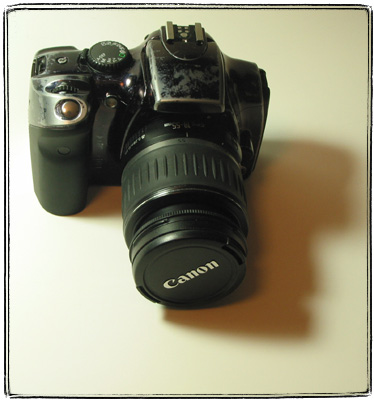I often get asked for advice on what digital camera to buy. I’d estimate that I was asked that at least a dozen times in the last couple of years. I’ve been asked by co-workers, friends, family.
I usually explain things this way: there are two classes of cameras — SLR and what used to be called “rangefinder“. SLRs range from bulky and heavy to galaxy sized black hole; from very expensive to small-Manhattan-studio-apartment-down-payment expensive. Rangefinders range from 007-spy-camera-sized to brick-sized; from very cheap to pretty damn expensive. The image quality on both types ranges from crappy to very good.
SLRs have one huge advantage: they look professional. And expensive. Two advantages. Well, actually while we are at it, there is a third advantage, and the only one that matters. Some SLRs come as a part of a camera system. A camera system is a collection of accessories that your camera can take. It includes lenses, flashes, extension rings, adapters, and other various obscure doodads like focusing screens and right angle viewfinders. Repeat with me – it’s not the camera body and the lens it comes with. It’s the System that matters.
When you are buying a non-system camera, you have to make a one piece investment as you won’t be able to upgrade it later. With system SLRs, your investment in lenses, flashes and other accessories is separate and much longer lasting than investment in the body of the camera. More than that, you’ll have a choice of several camera bodies at different price points. But the main thing is, you can have a lens and accessory collection and it will stay with you for many years.
In the olden days there were popular rangefinder systems and even TLR systems. Not anymore. But the main reason for rangefinder popularity still remains: they are smaller and easier to use than SLRs. A picture taken with a well-made rangefinder will be almost indistinguishable from that taken with a well-made SLR with a normal range lens (that is, not a macro or telephoto or something even more exotic). Rangefinders add something to photography that no SLR can add – spontaneity. To be able to whip a camera out of your shirt pocket and take a picture is priceless. 70% of photographic opportunities disappear in the time that it takes to take an SLR out of the bag.
I often try to steer people into buying a nice rangefinder because I know that they’ll take it with them more, take more pictures and enjoy it more. A camera that wants to stay at home is not of much use, unless, of course, like me, you are Ok with dragging a heavy bag with you everywhere.
If it’s the SLR that they want, I explain the choice even simpler. You have to buy into a major camera system, which these days means Canon or Nikon. Once you buy your camera and lenses, you are pretty much stuck with the system, unless you never buy any expensive lenses.
Canon and Nikon systems are pretty equivalent in quality and variety. They are both awesome. Generally Nikon stuff is heavier and sturdier, and also more expensive. Just about anybody finds that appealing. I find the relative heaviness a huge drawback. Picture quality at slow shutter speed is mainly limited by three factors: sensor quality, lens quality and camera shake. So, if you are not using a tripod for every shot, a heavy, although sturdy camera is a huge drawback – it will make your hands shake a lot more than a lighter one. For these two reasons I am, and always was a fan of Canon.
Most of the people I ever advised on purchasing a camera bought Nikons though. More than that, most of my friends and co-workers are Nikon owners already. As a rule of thumb, prosumers that I know like Nikons. In general, among professionals and amateurs, Canon and Nikon are represented equally, as far as I can tell.
I do have one observation that might raise a lot of controversy. I find, in my empirical observations, that Canon owners take and share way more pictures than Nikon owners. Nikons are usually found stashed away at home, while Canons are out there in the world, taking pictures. Since 2000, I took about 25K photos, and a I guess I am a typical Canon user. So is Travis Ruse, one of my favorite photobloggers. So is Tema Lebedev, my favorite travel blogger. What about you, Nikonophiles? Where are your pictures?
Philip Greenspun has a nice technical Canon vs Nikon comparison, as well as a good description of the Canon system, and one of Nikon.
I’ve added a camera-related poll.






